Stratocumulus Sheets - Meteorological Physical Background
by FMI and KNMI
- Synoptic scale flow and the properties advected by the air streams, e.g. moisture content, have an effect on formation of the cloud layer. Large-scale divergence in the lower troposphere in the vicinity of anticyclones produces subsidence. The air warms adiabatically and a persistent subsidence inversion may form on top of the boundary layer (BL). When the BL moistens or cools, the likelihood of stratocumulus clouds increases.
- On the other hand the development of Sc Sheets is controlled by small-scale factors in the atmosphere, such as turbulent mixing in cloud. Turbulence transports heat and moisture upwards and hence forms the mixed layer.
Schematically the vertical structure of stratocumulus-topped BL can be described as follows:
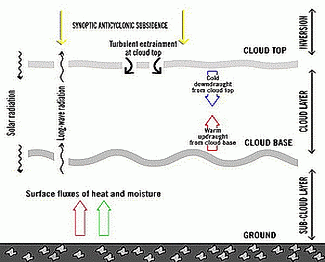
The mixing processes in a cloud layer are most important. Mixing processes are generated primarily by seven different mechanisms, which either support or dissolve the Sc Sheets. According to Stull (1991) they can be listed as follows:
- Post-cold frontal low convection.
- Low convection generated by differential cold advection. This occurs when more cold air is advected into an area aloft than is advected at lower levels. Such destabilization can occur even when the surface is cooler than the overlying air.
- Shear-generated mechanical turbulence associated with strong winds in BL can also cause sufficient mixing to maintain stratocumulus.
- Outgoing long wave radiation from cloud tops produces sinking air parcels, which mix the air in BL.
- Cloud base radiative heating is a much weaker process than cloud top radiative cooling, but as it destabilizes the cloud layer and/or stabilizes the subcloud layer, the effect can be a decoupling of the mixed layer.
- Cloud layer shear generates mechanical turbulence and mixing.
- Entrainment instability is a mechanism that enforces the pre-existing entrainment of dry air from above the cloud into the cloud. The effect of this is drying and warming of BL, rising of the cloud base and finally break-up of the cloud deck.
Radiative processes above, within and below the cloud sheet are important factors in stratocumulus development. Short-wave solar radiation as well as long-wave IR radiation from the surface generate convective instability, which in turn is released as turbulent eddies. Hence the radiative processes and turbulence are closely connected.
The vertical structure
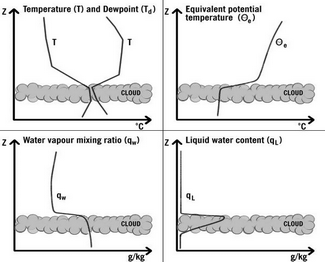
Favourable climatological and synoptic environments
Sc clouds are a common cloud type both in northern latitudes as well as mid-latitudes. They are most often observed over cool waters throughout the year but also over land areas, especially in winter. A good seasonal example can be taken from Finland: in southern Finland Sc cloudiness is observed most often during the period from September to December (35 - 50% of the time there are Sc clouds in the sky). The minimum likelihood for Sc clouds is during the period from May to August (10 - 20% probability for Sc cloudiness). Overcast skies (7 - 8 oktas) with Sc cloudiness are observed quite often (20 - 30% of the time) between late autumn and early winter, while in late summer widespread Sc cloudiness is virtually absent in southern Finland.Large-scale anticyclones represent one kind of favourable environment for Sc Sheets to form and develop, as the associated subsidence produces large-scale adiabatic warming and hence significant temperature inversions above the boundary layer. Climatologically, the most common (at least, most often referred to in meteorological literature) locations for extensive Sc Sheets are relatively cool waters such as the North Sea (see below) or the areas over cool oceanic currents adjacent to the North American west coast, where they have a quasi-permanent character. Sc Sheets in connection with high pressure ridges between frontal systems have a more transient character.
Over land Sc Sheets often form during the cool season either near the centre of high pressure (however, stratus formation is more likely there due to weak mechanical turbulence) or on the cool (eastern) side of it, where fresh and moist air flows in a shallow layer southwards (see cloud structure in satellite image ). An example of favourable locations for Sc can be found in eastern parts of Finland and adjacent land areas over Russia: cold, shallow and relatively moist north-easterly - northerly air streams east of an anticyclone cntered over, say, Scandinavia or the Norwegian Sea often cause an extensive Sc layer to form.
Sc Sheet formation is also often observed after a cold front passage as well as on the rear side of the low pressure. Cool air flow with reasonable wind shear, stable stratification and a large amount of moisture (not necessarily because of advection of moisture from the sea, but by evaporation of rain and from wet ground) form a suitable condition for Sc formation.
Sea areas are an example of a moisture source, which in synoptically favourable (anticyclonic) environments can produce long-lasting Sc Sheets. If the anticyclone is stationary causing steady wind conditions within the cloud sheet, the Sc Sheet can last even for several days without breaking up.
There are also other typical occasions when Sc cloudiness is reported. An example of this is the Sc cloudiness formed in summertime evenings by spreading of cumulus clouds. Sc clouds produced this way will not typically last for a long time. However, they can be seen even in satellite images (best in visible channel) as convective cellular daytime cumulus cloudiness turning into night-time Sc cloudiness with a smoother texture.
North Sea Stratocumulus: synoptical description
To get extensive sheets of stratocumulus over the North Sea without any cloudiness above, there should be an anticyclone over Great Britain. Crucial for the Sc Sheets is a temperature inversion and the presence of sufficient moisture along with some updraft to form cloudiness (unstable air in surface layer). With a north-westerly flow these Sc Sheets will penetrate the Netherlands. Mostly the high pressure over England is a blocking high of one of the following types:- either a diffluent blocking, when there is a corresponding low south of England;
- an omega blocking, when there is a low west of Ireland and a low over central Europe.
|
Example of omega blocking
|
Example of diffluent blocking situation
|
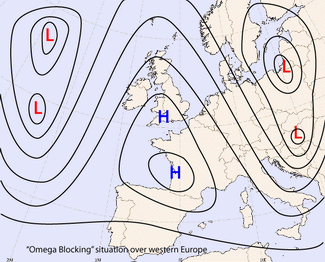
|
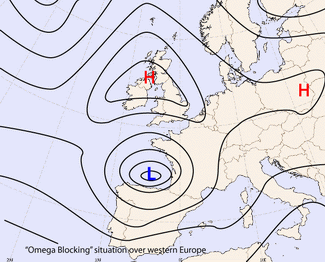
|
In HRVis_image of 06 June 2007 12.00 UTC there is an extensive high pressure area over the British Isles and Ireland. At the east flank of this high Sc Sheet is seen over west part of the North Sea and East coast of England. At central North Sea ULL cloudiness is superimposed over Sc-cloudiness. Also seen is the Sc Sheet above the Bay of Biscay.
|
06 June 2007/12.00 UTC - Meteosat 8 HRVis image
|
03 April 2007/12.00 UTC - Meteosat 8 HRVis image
|
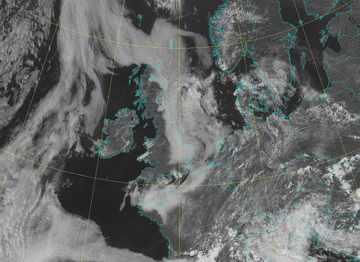
|
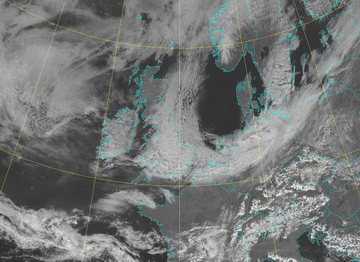
|
Also in the combination RGB of the AVHRR imagery of NOAA the Sc Sheets above the North Sea are quite remarkable. Especially the structure of the cloud tops are well seen in these yellow areas above the whole North Sea.
|
02 July 1997/13.26 UTC - NOAA RGB image (channel 1, 2 and 4)
|
02 July 1997/06.29 UTC - NOAA RGB image (channel 1, 2, and 4)
|
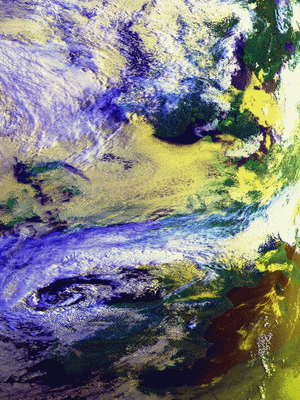
|
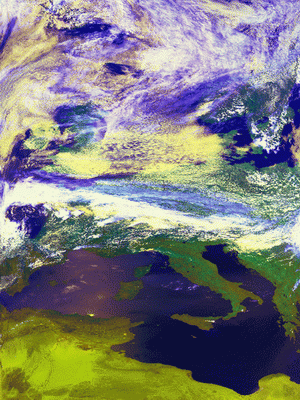
|
Typical life cycle of Sc Sheet
Sc clouds - when the environments are favourable - have a tendency to spread beneath the limiting temperature inversion and later have a large horizontal extent. This can sometimes be seen also in satellite imagery as rapid spreading and coalescence of initially smaller-scale cloud elements. The remarkable differences, both in radiation and turbulence factors, between the adjacent cloudy and cloud-free areas have an effect on the horizontal spreading of the Sc Sheet. Typically during the daytime (especially during summer months) the sun heats the lowest layers of cloud-free areas, the result being only fair-weather cumulus cloudiness. The solar radiation can even affect the edges of Sc Sheet and slow down its spreading. Hence the initially cloud-free areas close to the Sc Sheet can stay cloud-free all day. This feature can often be seen in Finland in connection with summertime outbreaks of cold air from the White Sea: the Sc Sheet is at first rapidly advected to eastern Finland and Karelia. However, later during the day the edges of the cloud start to erode and further movement of the sheet stops, as solar radiation dries and warms up the cool boundary layer ahead of the cloud sheet.The most permanent and extensive Sc Sheets form, as previously mentioned, mostly in connection with cool and moist air streams. As Sc Sheets often form in the vicinity of anticyclones, their movement can be slow. If strong upward motions generated by fronts, depressions, etc. are absent, the development of the Sc Sheet is driven mainly by slower processes, such as large-scale subsidence. Thus, the appearance of the Sc Sheet can be identifiable for a longer period. In some cases an individual Sc Sheet can last days without significant change. Entrainment instability at the cloud top is needed for breaking up this kind of quasi-permanent cloud sheet. The more the cloud sheet breaks up, the more solar radiation penetrates it, hence generating a positive feedback for the continuing dispersal of cloud, given sufficiently low humidity of boundary layer air.


